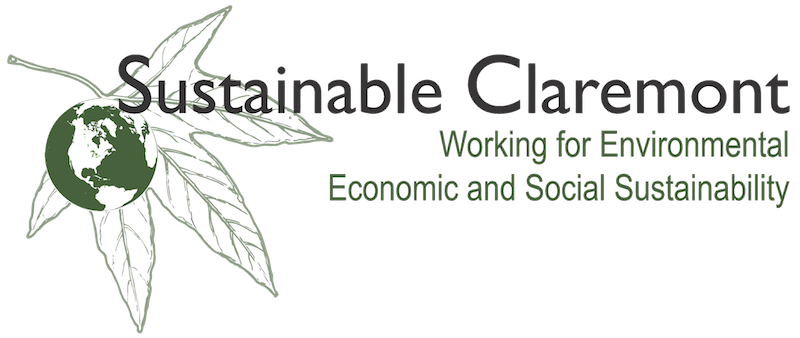Now is a time of extraordinary promise for planning a sustainable future. Claremont’s Sustainable City Plan, first adopted in 2008, is being updated and is scheduled for October adoption by the City Council. It’s an opportunity to suggest new goals and directions. The more of us that put our minds to this, the better the result will be. The update should include more about what our community is doing, so your suggestions will be particularly important. The current plan is posted on the City web site (ci.claremont.ca.us).
Claremont is already distinguishing itself among Southern California cities. It is one of only four cities to be recognized with Silver status as a Southern California Green Community. Many good things are happening. The municipal corporation is on course to achieving the goal of 20% water use reduction by 2012, and the community has already exceeded that goal. But there is still much to be done, such as achieving the 20% energy reduction goal (over 2003 levels) by 2015. There has been real progress in becoming more energy efficient, but both the City and the community are adding new load that offsets these gains. Lighting for the new Padua Avenue Park and purchase of new TVs and other electronics are examples.
Sustainable Claremont has several initiatives underway. The water reclamation plant proposed by Richard Haskell and the Water Action Group has moved forward at a remarkable pace. A detailed engineering feasibility has been funded by the Council of Presidents of the Claremont Colleges. This project will replace an average of 200,000 gallons per day of imported potable water now being used for irrigation on the campuses. The projected positive return on investment makes this a particularly attractive project. Sustainable Claremont’s CHERP (Claremont Home Energy Retrofit Project), chaired by Sheila McCarthy, has far exceeded other cities in the County in the number of homes retrofitted under the Energy Champions program. There are energy savings, the homes are more comfortable to live in, and an estimated $800,000 has been added to the local economy. Ron Mittino’s Schools Action group has promoted sustainability in the schools, school gardens, and good nutrition. Interns from the Colleges and students in the Environmental analysis programs have benefited from working on real-world projects where they make important contributions. For example, an intern working with Susan Schenk prepared a GIS map of all open space in Claremont. In a very recent project, Kristin Miller’s Solid Waste Action Group is beginning a study of composting and use of dehydrators for food waste. Surprisingly, food waste makes up almost a third of the waste going to landfills. The savings in transport and tipping fees might result in a positive return on investment, and the products will be useful soil amemndments.
Tom Helliwell, who chairs the Claremont Interfaith Sustainability Committee, has taken the lead on installation of solar panels that will provide all the electrical power needs of the UCC church. That, again, will have a positive return on investment as well as having a major energy conservation benefit. Uncommon Good, headed by Nancy Mintie, is nearing completion of an “ultragreen” superadobe building that will be an impressive “first’” for Claremont. The Claremont Colleges continue to win awards in recognition of their green buildings.
While the update of the City Sustainability Plan is underway, it seems sensible to think of developing a “climate action plan” A sophisticated computer model has recently become available to easily project likely local temperature increases and hydrologic changes. The analysis for Claremont has not yet been run, but there is data for sites in the adjacent Santa Ana Watershed. At one station, where detailed projections have been posted on the web, the predictions are for a 1 degree F increase by the 2020s, 3 degrees by the 2050s, and 4 degrees by the 2070s (so far the increase due to global warming has been about 1.5 degrees). Rainfall is predicted to increase slightly through the 2020s, and then to decrease.
Water and energy supplies will clearly be important in our future. So will food. A separate Goal Area on food and agriculture should be considered for the updated Plan, and a community meeting is being planned to consider possible goals.
Devon Hartman has suggested Claremont become an “innovation incubator” to encourage projects that benefit sustainability and have positive economic and social benefits.
These are examples of sustainability projects in Claremont. There are many more. The colleges each have sustainability plans, as do others. It seems as if it would be timely to have a community meeting to review all that is happening. New ideas will surely come from that. Why not then develop a coordinated community-wide sustainability plan? Sustainable Claremont would be pleased to convene such a meeting. Please let us know if you would like to join in the dialogue – and drop by Sustainable Claremont’s booth on the 4th!
Demystifying Sustainability is an initiative of Sustainable Claremont (sustainableclaremont.org).
